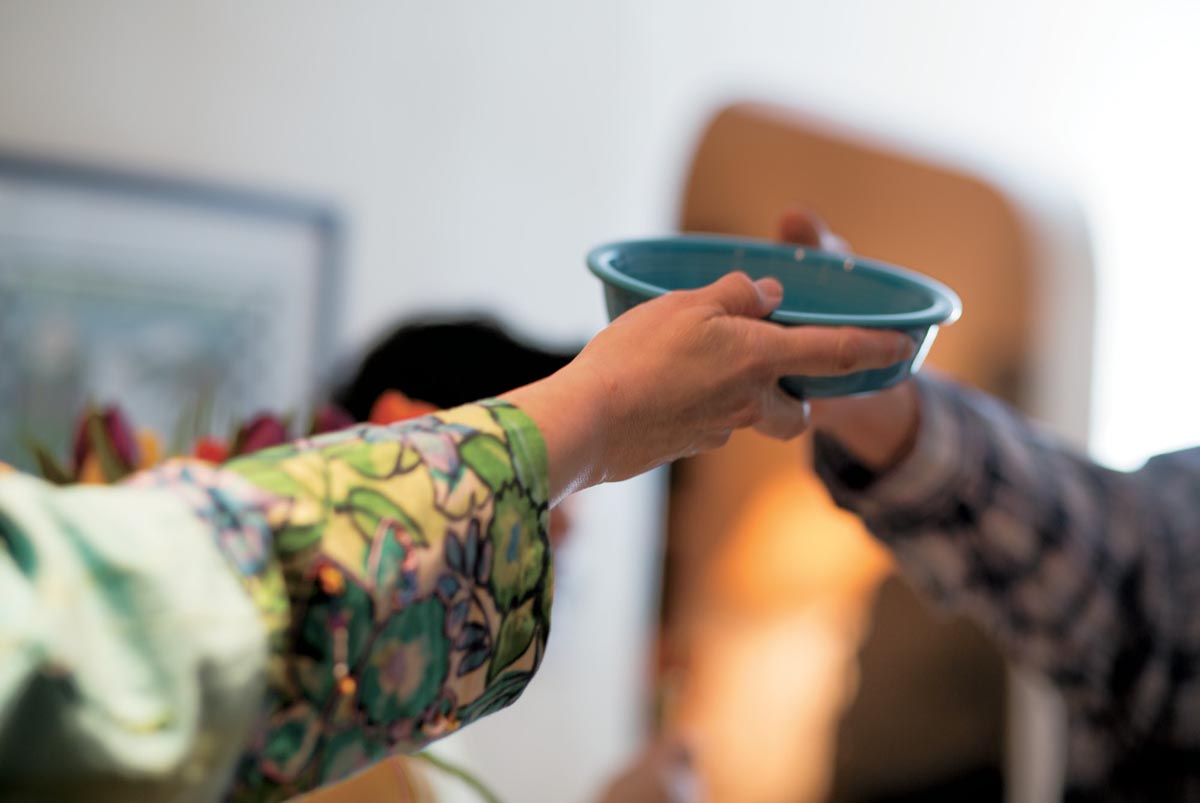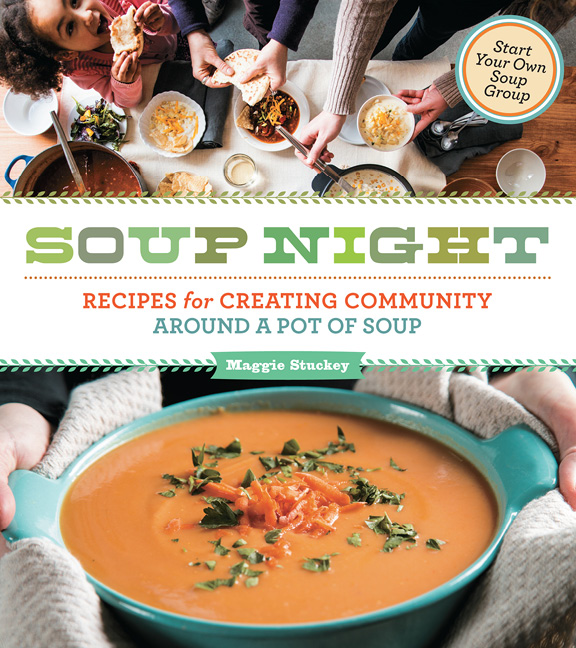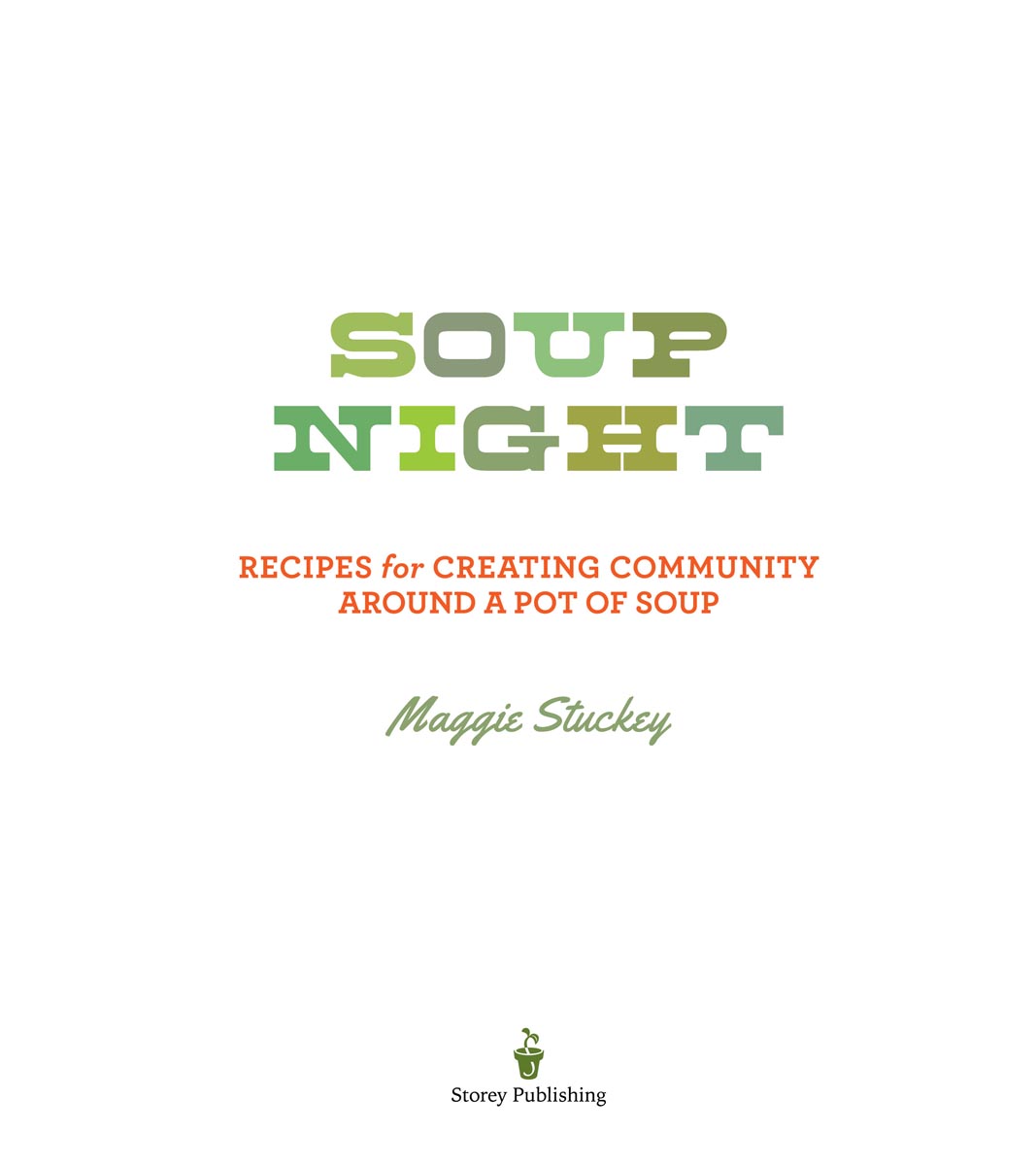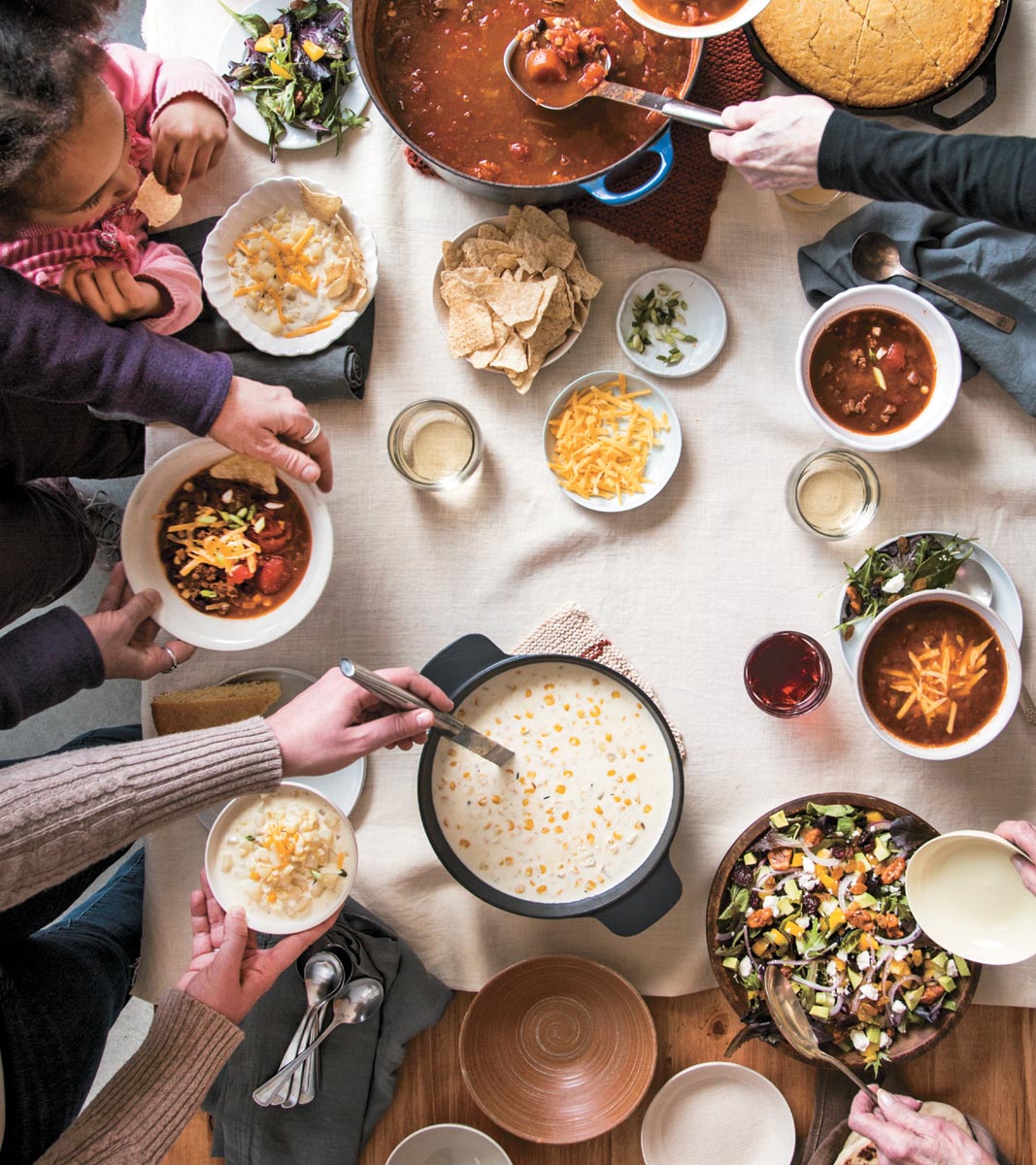Contents
Introduction
Welcome to Soup Night!
At latitude 45 degrees 30 minutes north, almost exactly halfway between the equator and the north pole, its fully dark by 6 pm in January. In Portland, Oregon, the streetlights have been on for almost an hour. A bit before 6, in an older, sedate neighborhood on Portlands urban east side, front doors all up and down the street begin to open. For the next 10 to 15 minutes, individuals, couples, and families come out their front doors and stroll easily but with purpose in the same direction. Theyre all heading toward the same house, just about in the middle of the block, on the left-hand side.
Everyone is carrying something. Some of the adults have gigantic salad bowls, or warm bread wrapped in dish towels, or those familiar rectangular pans that hold the promise of homemade brownies. Some have a wineglass threaded through the fingers of one hand. Kids skip ahead, bright plastic cups firm in little fists or looped onto belts through the handle. Most people have spoons, wrapped in paper napkins and tucked into jeans pockets. One dapper fellow wears a cloth napkin folded just so in the breast pocket of his sports coat, like a fancy silk handkerchief; one soup spoon stands in the exact middle. And each person in this gentle parade carries a soup bowl. An empty soup bowl.
Its Soup Night on Stanton Street.
My First Soup Night
My brother and his family live on the Soup Night street. One day some months ago, my niece Meg (the most spectacular teenager in the western hemisphere) happened to mention Soup Night in the midst of telling me about something else. Whoa, I said, back up. Whats Soup Night?
As she started describing it, in the first five seconds I knew this was something very special. So I contacted the next host and asked if I could come as a guest. That first evening, I was totally enchanted at the sight of the parade of people strolling down the sidewalk, carrying their empty soup bowls. When I arrived at the host house, people assumed I was new to the neighborhood. They immediately shook my hand and introduced themselves, pointing out where their house was in relation to where we were standing. It wasnt long before I was able to make it plain how I was connected (my brother lives on your street), and why I was there (I want to write about you). But it was absolutely clear that if I had been a new neighbor, I would have been engulfed in a very warm, very genuine welcome.
Everyone wants to live on this street. People go door to door, trying to find someone whos thinking of selling.
Marty
Since that first evening, I have attended more than a dozen Stanton Street Soup Nights. Over and over, I have heard the families talk about, and have observed for myself, the almost magical sense of community that they have created on their block, and the many ripples of positive benefits that flow from it. I have been happy witness to some amazing scenes and heard some great stories, and together they form the core of this book.
Neighborhoods and Neighborliness
Stanton Street runs eastwest through the Irvington neighborhood in inner Northeast Portland that is, smack in the urban core. In a city known for strong neighborhood associations and liberal politics, Irvington stands out on both scores. It is settled, sedate, and quiet a grand old lady of a neighborhood. The streets are wide, the trees are tall, the garages (if any) are tucked away behind the house or off to the side. The houses date from the early part of the twentieth century: a mix of Craftsman bungalows, Foursquares (which in Portland are called Old Portland), and a few architectural styles with no specific names except traditional.

This particular block of Stanton Street mirrors the overall look and feel of the larger Irvington neighborhood. (By the way, I should tell you that the amazing close-knit block that started me thinking about Soup Nights is not actually on Stanton Street. Its very close by, but not on that exact street. I shifted the geography ever so slightly to give these folks a little bit of privacy protection. Besides, I quite like saying Stanton Street Soup Night. In the interest of complete disclosure, I should also tell you that I played around with time, in this one way: I smooshed some scenes together, as if they had happened on the same night.)
It is completely residential and, in spite of a cheerful cacophony of kid noises, has an air of serenity. All the houses are single-family homes; large mature trees line the street on both sides; there is minimal auto traffic. Most houses boast a pretty garden or cool green lawn in front, and in every single case this is very important the front yard is open to the sidewalk. There are no privacy fences, no gates, nothing that walls off any one home from the rest of the block.
Urban planners, take note: By this one simple measure, a profound sense of openness, of inclusion, is created. And it perpetuates itself. There is nothing in the city ordinances or building codes that would prevent anyone from adding these features to their front yard, but on this block, no one would even think of doing such a thing. It would close them off from their neighbors.
Stanton Street is in most ways typical of the larger Irvington neighborhood of which it is a part, and Irvington in turn epitomizes many of the qualities that have put Portland on the progressive map. Portland has, for one example, developed a national reputation for its strong network of neighborhood associations and the official support structure for them within city government. Irvington has such an association, and it is one of the largest, most active, and most effective. In the Irvington neighborhood, no one need go bowling alone. So, by all accounts Portland already has in place the climate necessary for a deep and abiding sense of community among all its citizens. And yet....
We make community out of the people who are right around us, right here in the neighborhood. These are not people we were already connected to, but now we are. Thats the positive energy of Soup Night.
Alex
And yet in parts of Portland it is still possible to see scenes like this: Women and men drive home from work, climb tiredly out of the car, perhaps wave to the next-door neighbor if that neighbor is in sight, then go inside and stay there for the rest of the evening. No further contact outside the walls of their own home, not this night, or tomorrow night, maybe not even on the weekend. This kind of pattern develops before you know it, and hardens, and then it takes a deliberate strategy to break out of it. Its sort of like gaining weight it sneaks up on you a little at a time, until you must grab hold and act with purpose to turn things around.
On Stanton Street, they did it with Soup Night.
Everyone Is Invited
The Stanton Street Soup Night was designed from the very beginning as a way to bring neighbors together. Everyone on the block every single person, corner to corner, on both sides of the street is invited. The whole idea is for neighbors who might not otherwise have a natural point of contact to get to know one another. Through the simple act of sitting down to a meal together on a regular basis, even people who have very little in common build a genuine relationship.















